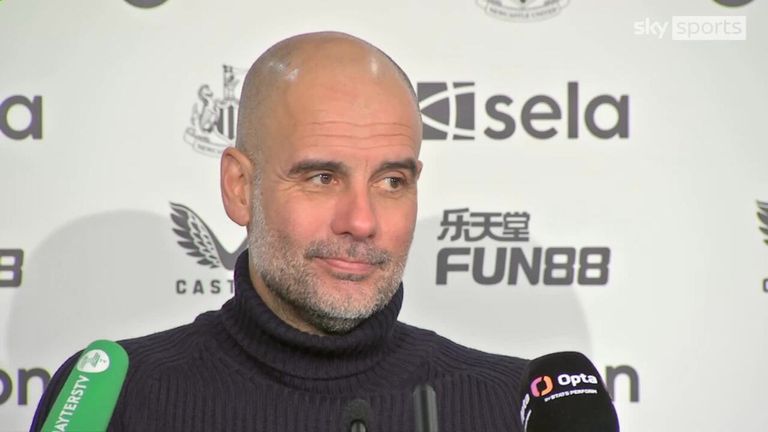Man City boss Pep Guardiola on his side’s win at Newcastle: “That was really good. It was incredible from the team, the way we played with a huge personality. They showed me they want to be there, to fight until the end that they want to retain the title”

Manchester City manager Pep Guardiola praised the return of Kevin De Bruyne after his match-winning contribution from the bench against Newcastle
Pep Guardiola declared his players had shown him their title-winning desire as they dug deep to complete a last-minute turnaround and win 3-2 at Newcastle.
The Premier League champions, who won only one out of six matches in the Premier League before their Club World Cup victory in December, have now picked up maximum points in each of their three league games since their return from Saudi Arabia.
Saturday’s win at St James’ Park was easily their most testing, trailing 2-1 with 16 minutes to go before the returning Kevin De Bruyne proved vital for their comeback victory with a goal and an assist to lift them two points off leaders Liverpool.
- Newcastle 2-3 Man City – Match report and highlights
- How the teams lined up | Match stats
- Live Premier League table | Fixtures | Results
City’s hopes of a fifth Premier League crown from six seasons had looked in real jeopardy in mid-December, when a 2-2 draw against Crystal Palace gave Arsenal and Liverpool the opportunity to move respectively five and six points ahead of them.
But not for the first time in recent years, City have bounced back from being written off to put themselves firmly back in the title race, with Guardiola paying tribute to his players’ mentality after their latest victory.

Highlights from the Premier League as Newcastle took on Manchester City
“That was really good, sometimes it is better winning that way for the team, for everything,” he told BBC Sport. “It was incredible from the team, the way we played with a huge personality.
“They showed me they want to be there, to fight until the end that they want to retain the title.”
In his press conference, he added: “I had the feeling we would do it, with the way we played against Huddersfield I felt the team was alive.
“We won five of the last six, why not? Of course, it’s important because Liverpool are flying – and we have to still go to Anfield so it’s better to be close to them.”
De Bruyne hails ‘important’ victory at Newcastle
Oscar Bobb’s winning goal, set up by Kevin De Bruyne, sparked jubilant celebrations on the Man City bench and those scenes were repeated at the final whistle as the gap to Premier League leaders Liverpool was cut to two points.
Of City’s title challenge, De Bruyne said: “To come here is always difficult and I think everybody was really happy for me, obviously, with everything that happened this year.
“We want to try and compete again for the league and we are there with all the other teams. To win here at St James’ Park against a really good Newcastle is tough, so it’s important.”
- Watch free Premier League highlights
- Stream Sky Sports on NOW | Get Sky Sports
Pep: ‘Special’ De Bruyne boosts our title chances

Image: Pep Guardiola celebrates with Kevin De Bruyne at full-time at Newcastle
Guardiola is relieved to have “special player” De Bruyne back in his ranks after the Belgium midfielder’s cameo inspired Manchester City to victory at Newcastle on his return to Premier League action.
The 32-year-old, who had not made a league appearance since August because of injury, endured a disappointing start to his evening on Tyneside when he drilled a free-kick harmlessly into the defensive wall with his first touch.
But he drew City level within five minutes of his introduction and then set up fellow substitute Oscar Bobb to snatch a 3-2 victory in stoppage time.

Asked about his contribution, Guardiola said with a smile: “I am so disappointed in him and upset and grumpy because the free-kick, he didn’t score a goal.
“Apart from that, I had the feeling he was not ready for 90 minutes after five months. We cannot forget – people say, ‘OK he’s ready, he can play after five months 90 minutes’.
“It’s not the case, so that is why he was in that situation. But we had control of the game and his impact in the last 35 minutes, the goal, the assist and how many times he arrived at the byline for the crosses…
“He is a special player. He is a legend, he is beloved by our people and he is fresh in his mind because five months is a lot of time. Hopefully, in the second part of the season, he can help us be there until the end.”
Analysis: De Bruyne shows Man City what they’ve been missing
Sky Sports’ Oliver Yew:
It didn’t take long, did it?
Any team would miss Kevin De Bruyne. Even a team of the quality of Pep Guardiola’s Manchester City. He’s just that good and he showed his full repertoire in 25 minutes on the pitch at St James’ Park.
With City trailing 2-1, Guardiola called upon the Belgium international in the 69th minute. He was straight into the action. Precisely four minutes and 34 seconds after his introduction, he found space in between the lines before driving at the heart of the Newcastle defence. You knew what was coming next as the ball flashed between Fabian Schar’s legs and beyond the dive of Martin Dubravka to nestle in the bottom corner.
Despite Newcastle’s grit and determination in defence, a City winner felt inevitable. De Bruyne’s contribution felt inevitable and this time it was an inch-perfect angled pass for Oscar Bobb to convert for the winner.
It was like De Bruyne had never been away.
City’s celebrations after the dramatic win centred around the 32-year-old. His team-mates know his importance. Guardiola knows his importance and his return makes the Premier League title favourites even stronger.
“He’s a special player, a legend,” Guardiola said. “He’s stretching his mind, five months is a long time and hopefully he can help us be there until the end in the second half of the season.”
Despite some uncharacteristic results this campaign, many have found it difficult to turn their back on City when predicting the winner of the race for the title. A few bravely did, but after seeing De Bruyne’s impact, it will be difficult to find anyone backing against City now.
‘I miss this’ – De Bruyne says willpower was decisive in impressive cameo

Image: De Bruyne made his first Premier League appearance since injuring his hamstring on the opening day of the season
De Bruyne felt sheer willpower was the decisive factor after his game-changing substitution at Newcastle.
De Bruyne said: “I’ve missed this. I had a big injury and I needed the time off but I worked hard.
“To come here, to this stadium, in this environment – I think it was more willpower than sharpness.

Image: Second-half substitute Kevin De Bruyne celebrates scoring Man City’s second goal
“I know I’m not able to do that for 90 minutes at the moment but I can put in a shift for 20-25 at full pace. I can feel it in my lungs with the cold, but it can’t be any better than this can it?”
With City trailing 2-1 at half-time, it took the introduction of De Bruyne in the 69th minute to turn the game in
City’s favour.
Asked if he had expected to get back up to speed so quickly after injury, De Bruyne said: “No, not at all.
“Honestly, I didn’t know what to expect. I’ve never experienced this in 14 years that I’ve been playing football. But I worked really hard. I tried to change a couple of things because I had the time. When you are playing all the time it is difficult to do different things. Hopefully, I can maintain that.”
Twitter This content is provided by Twitter, which may be using cookies and other technologies. To show you this content, we need your permission to use cookies. You can use the buttons below to amend your preferences to enable Twitter cookies or to allow those cookies just once. You can change your settings at any time via the Privacy Options. Unfortunately we have been unable to verify if you have consented to Twitter cookies. To view this content you can use the button below to allow Twitter cookies for this session only. Enable Cookies Allow Cookies Once He’s back!
- Kevin De Bruyne has scored (one) or assisted (three) a goal in all three of his substitute appearances in all competitions this season.
- His goal was Man City’s 100th in the Premier League against Newcastle, the first side they’ve netted a century against in the competition
- 28 of De Bruyne’s 65 Premier League goals have come from outside the box – of players to score at least 50 in the competition, only David Beckham (55 per cent) has netted a higher share from distance than the Belgian (43 per cent).
- The Belgian became the first City player to both score and assist in a Premier League game as a substitute since Sergio Aguero vs Cardiff in January 2014.
Howe: You hope KDB is rusty and then he delivers that!

Newcastle manager Eddie Howe heaped praise on Manchester City’s Kevin De Bruyne for his late goal and assist against the Magpies
For Magpies boss Eddie Howe, there was pride in a fine display, but one which ended in disappointment to join a series of near misses this season against teams including Liverpool and Paris St-Germain.
“There was so much promise and so many good things, so to be sat here with nothing is very, very painful,” Howe said.
“The lads have given so much physically in that game. The first half was everything that we want to be. We wanted to be aggressive and front foot. When you do that, you take risks, but those risks were worth it.
“You could see that it paid off at the other end. We still wanted to do that in the second half, we still wanted to play the same way, but we just couldn’t deliver that in the second half.”
Twitter This content is provided by Twitter, which may be using cookies and other technologies. To show you this content, we need your permission to use cookies. You can use the buttons below to amend your preferences to enable Twitter cookies or to allow those cookies just once. You can change your settings at any time via the Privacy Options. Unfortunately we have been unable to verify if you have consented to Twitter cookies. To view this content you can use the button below to allow Twitter cookies for this session only. Enable Cookies Allow Cookies Once
On De Bruyne’s contribution, Howe added: “You just hope he’s rusty and not up to full speed yet, but then he comes on and delivers that and you think, ‘Well, there’s no rustiness there’.”
“He crosses the ball so well, for the majority of the time he was on we dealt with those situations well, but for his goal, we didn’t defend well enough, and for the assist at the end, that was hugely frustrating with just three minutes to see out, you thought we were almost there.
“It was a really good first-half performance from us. End-to-end, brave football. We probably ran out of gas in the second half.
“It looked like we had done enough for the point, with the way we defended you’d have backed us to see it out but we couldn’t do it in the end.”
What’s next for Newcastle and Man City?
Newcastle will benefit from a two-week break before their next engagement, which is a trip to face Fulham at Craven Cottage in the fourth round of the FA Cup on January 27.
They return to Premier League duty on January 30 when travelling to Aston Villa; kick-off 8.15pm.
Manchester City also have FA Cup commitments on January 26, facing Spurs at the Tottenham Hotspur Stadium, before a return to Premier League action sees Vincent Kompany’s Burnley travel to the Etihad on January 31; kick-off 7.30m.
Sourse: skysports.com